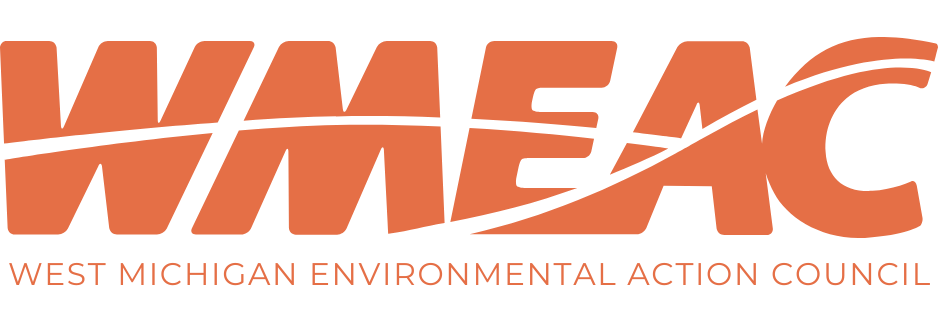By Tanya Cabala, Lakeshore Outreach Organizer for West Michigan Environmental Action Council
This blog was originally published in the Grand Haven Tribune as part of WMEAC’s monthly opinion piece series. We are pleased to share it with our readers in this new format.
We are so very fortunate to live near the largest lake entirely within the U.S. (Lake Superior is superior indeed but we share it with Canada). We are even more fortunate that our West Michigan shoreline features a globally significant coastal dunes system, comparable to major formations in other states and countries.This system is a cherished part of our state’s natural heritage and the economies of our shoreline communities. Having been deeply involved in dune protection efforts for decades, I’ve witnessed both triumphs and setbacks in safeguarding these delicate ecosystems. I am encouraged by the introduction of two bills before our state legislature focused on their protection introduced by two West Michigan state legislators, Representatives Joey Andrews (D-St. Joseph) and Rachel Hood (D-Grand Rapids). Addressing the challenge of balancing human use with the preservation of ecological values is complex, but this legislative effort offers a much-needed framework to improve the delicate balance between environmental stewardship and responsible development.
The Value of Michigan’s Dunes
The Grand Haven area, like many places along West Michigan’s coastline, is characterized by its relationship with its dunes, which contribute to its unique sense of place. This is exemplified by the long-standing efforts to protect the Rosy Mound dunes, which began in the mid-1960s with enthusiastic local schoolchildren. Persistence paid off in 1994 when Rosy Mound was officially designated a protected dune area. This same spirit of dedication is evident in the protection of other valued dune areas, such as the beloved Kitchel-Lindquist Dunes Preserve.
For over 30 years, I’ve been honored to serve as an environmental advocate and, as a devoted lover of dunes, am especially proud to work these past four years for the West Michigan Environmental Action Council (WMEAC). In 1976, WMEAC played a pivotal role in the passage of Michigan’s Sand Dune Protection and Management Act, which aimed to regulate industrial sand mining on the lakeshore. As lakeshore living evolved and seasonal cottages transformed into larger permanent homes, the Act was amended in 1989 to designate a subset of Michigan’s 275,000 acres of coastal dunes as “critical dunes” requiring protection from intensive residential development. However, from my perspective, the Act was somewhat insufficient in both respects, and subsequent amendments in 2012 further reduced protections.
Proposed Sand Dune Protection Legislation
Enter the package of two sand dune protection bills that aim to modernize regulations, restore critical protections, and improve transparency and public input in decision-making processes.
Representative Andrews’ bill clarifies that mining in critical dunes, regardless of its purpose—industrial, commercial, or residential—is classified as mining, and it requires reclamation of mining sites. Representative Hood’s bill requires developers to demonstrate that their proposed developments in critical dunes are safe for people, communities, and ecosystems. It also aims to establish a transparent permitting process for local and state governments, with improved funding through associated fees.
Both bills seek to increase public involvement by ensuring accessible documentation and public meetings for proposed developments.
Building a Strong Constituency for Dune Protection
Looking ahead, safeguarding Michigan’s coastal dunes requires more than legislation-–it demands a multifaceted approach. By integrating education, community education and engagement, research and preservation programs, we could more effectively forge a sustainable path for these fragile ecosystems.
A comprehensive strategy that assesses the current status of our dune system and future challenges, and actively engages Michigan citizens in support of dune protection could prove especially beneficial. As part of that, a statewide public education campaign raising awareness about dune ecology, promoting responsible recreation, could more effectively involve communities in safeguarding these natural treasures. Ongoing scientific research is crucial to understanding how to manage human interactions with the dunes, guiding best practices for conservation and sustainable use. Increased funding for preservation programs is essential, enabling the acquisition and protection of more dune land and ensuring these ecosystems flourish for future generations.
Locally, residents can contribute to preserving Ottawa County’s dune areas through various volunteer and educational activities. At Kitchel-Lindquist Dunes Preserve, people can participate in restoration projects, adopt-a-trail programs, and attend educational events. Rosy Mound Natural Area offers opportunities for dune conservation work and support for park expansion. P.J. Hoffmaster State Park encourages joining the Friends Group, participating in interpretive programs, and engaging in beach cleanups. Additionally, North Beach Park and Ottawa Sands provide opportunities for dune protection and education, with programs designed to teach visitors about dune ecology and sustainable practices.
Michigan’s coastal dunes are irreplaceable natural treasures, vital to both our environment and economy. The proposed legislation presents a path forward that balances responsible development with the need for conservation. However, legislation alone will not suffice. It is up to us to protect these fragile ecosystems for future generations, ensuring that Michigan’s unique and fascinating dune legacy endures.
For more information about WMEAC, see www.wmeac.org.


